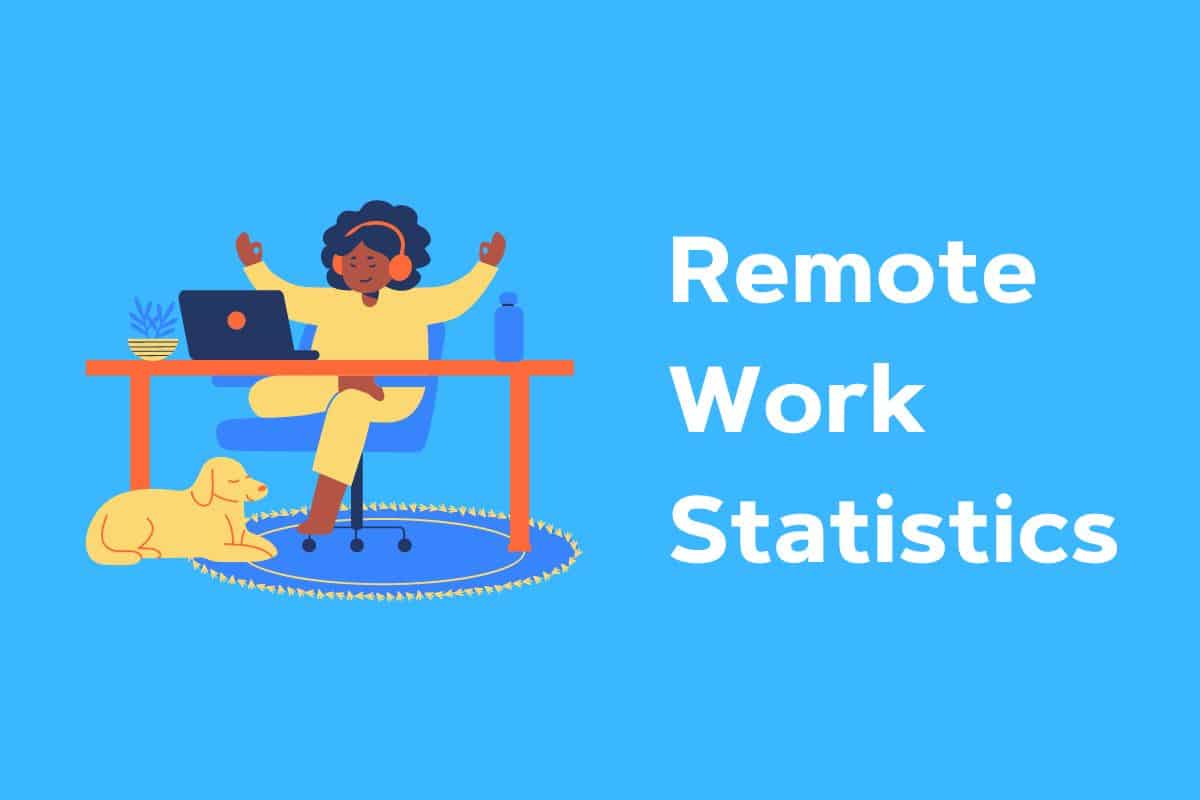Remote Work Statistics (How Many People Work From Home?)
Are you trying to find a comprehensive list of remote work statistics because you’d like to know how many people work from home, what the most significant benefits are, and more?
Remote work has become very popular over the past years among employees and employers alike.
While working from home was considered a luxury just a few years ago, the COVID-19 pandemic made it widely popular and acceptable.
Many companies were forced to switch to telecommuting, only later to find that their employees became much more productive, plus the enormous amount of money they saved.
Even post-pandemic, remote work (full- and half-time) is still increasingly popular, allowing employees more flexibility.
Let’s together check all these interesting remote work statistics and trends.
This post covers:
- How Many People Work From Home?
- Benefits Of Remote Work Statistics
- Challenges Of Remote Work Statistics
- Other Remote Works Statistics And Trends
Remote Work Statistics (Our Top Picks)
- 260 million permanent remote workers
- Time flexibility is the biggest benefit of working remotely
- But almost 60% of employers name cost savings as the main benefit of remote work
- Remote workers are 57% more productive
- Remote work reduces attrition
- Nearly 1/3 of remote workers feel isolated/disconnected
- 45% find career growth challenging as a remote worker
- Businesses could save $600 billion going remote
Remember, we also have a complete list of the most interesting cloud computing statistics, something that’s a must for remote work.
How Many People Work From Home?
The number of people who work from home depends on the country, industry and job type. Thus, typing down even an estimated global number of people working from home is impossible.
Moreover, although the pandemic made remote work popular, many companies are switching back to on-site or implementing hybrid work.
1. 260 million permanent remote workers (before the pandemic)
This was the closest number we could find regarding how many global remote workers there are – an estimated 260 million, which is 7.9% of the global workforce.
But it’s said that around 18% of workers worldwide have the technology and infrastructure to switch to telework exclusively. (In high-income countries, up to 23%, while in low-income countries, 10% less.)
Source: CEPR
2. Around 33% of US employees worked exclusively remotely in 2020
In 2020, three out of ten workers worked remotely, while over 50% (70+ million) of US employees could do their job from home (but only two in ten did).
Moreover, five in ten worked as hybrids (part at home, part on-site) and two in ten were 100% on-site.
Remember, fully remote work arrangements nearly tripled when comparing the pre- and post-pandemic era.
Source: Gallup
3. Entirely remote work is expected to decrease
While hybrid is increasing (going from 42% in February 2022 to 49% in June), fully remote work arrangements are decreasing. Still, nearly one-third of employees want to work permanently from home.
What’s more, the US Bureau of Labor Statistics reported a decline in remote work, too. The rate of businesses where employers rarely or never teleworked increased by more than 12% between 2021 and 2022.
Source: Gallup, Bureau of Labor Statistics
4. 50% of Australians are considering permanent remote work
In a survey from June 2022, more than 50% of Australian employees would consider signing up for a permanent remote work contract. On the contrary, fewer than 25% are not interested.
Furthermore, 85% said that they would like to work from home at least one day per week, but most employees would prefer working remotely every day. Only 17% said they’d never work remotely.
Source: Statista
5. 5.1 million Canadians worked from home in May 2021
In May 2021, 5.1 million Canadians worked from home, slightly decreasing from January (5.4 million) to February (5.2 million). This represented 32% of Canadian employees working from home, a massive jump compared to only 4% working (mostly) from home in 2016.
Source: Statista
6. 1.1 million people worked from home in South Korea in 2021
The most significant increase in remote work in South Korea was in 2021, from 66,000 in 2015 to 1.1 million. But in 2022, it lowered to approximately 956,000.
The most open industries to remote work were/are finance and insurance, arts, sports and recreation-related jobs.
During the pandemic, more than 60% of large South Korean companies implemented (or planned to implement) remote work for safety reasons.
Source: Statista
7. Nearly 2 million Spaniards worked from home in 2020
During the COVID-19 pandemic, almost two million Spanish people worked from home, the highest recorded figure in history. In addition, the Madrid and Catalonia areas had the highest share of teleworkers, at 12.5% and 7.6%.
A study also pointed out that 60%+ of highly educated individuals are more eligible to work from home, while only 26% of people who are less educated.
Source: Statista
8. In 2021, 31%+ of Italians worked remotely
Out of the 7.3 million, on average, 27% were altering between company and home office, and 15% were working exclusively from home. The number of employees working from home was much higher than self-employed individuals working remotely.
Source: Statista
Benefits Of Remote Work Statistics
9. Time flexibility is the biggest benefit of working remotely
With a 67% share of total respondents ticking the same reason, the most significant advantage of working from home is “Flexibility in how I spend my time.”
The eight main benefits of working remotely:
| Benefit | Share of respondents |
| Flexibility in how I spend my time | 67% |
| Flexibility to choose my work location | 62% |
| I have more time because I don’t commute | 59% |
| Flexibility to live where I choose | 55% |
| It’s better for me financially | 48% |
| The ability to better focus in my work | 44% |
| I feel safer | 32% |
| Flexibility in my career options | 29% |
Source: Statista
10. Remote workers are 57% more productive
While it’s usually thought that working from home makes people less products, that’s not the case. In fact, 57% of employees say they’re more productive working from home. On the contrary, only 17% say they’re less effective.
What’s also interesting is that, on average, employees who work from home work around 17 days more every year than those working in the office.
A survey by Buffer found that 40% of remote workers work more and 40% the same. But 20% work less. So this is another proof that lower productivity isn’t really an issue with teleworking.
Source: TrustRadius
11. 62% of workers are more excited about their job after switching to remote work
When asked if they were more or less excited about the job after transitioning to working from home, 62% said they were more excited, which also tells why they are more productive. Only 10% said they’re less enthusiastic, but remote work has no impact on the rest.
Source: Buffer
12. Almost 60% of employers name cost savings as the main benefit of remote work
Almost six in ten employers reported that cost savings is one of the biggest benefits of employees working from home. Companies save anywhere from $1,000s to $10,000s per employee who works from home, or they don’t have to relocate them.
This could easily mean multiple 100s of billions of dollars saved yearly globally.
Source: Global Workplace Analytics
13. Employees can save, on average, $4,250 per year for half-time remote work
Working half-time remotely can save employees $2,000 to $6,500 per year. And these numbers could increase significantly with full-time remote work because of further reduction in the cost of commute, food, daycare and clothes, to name a few.
Not just that, but a full-time teleworker can move to a place where the cost of living is lower.
Source: Global Workplace Analytics
14. Less stress, illness and injuries
Stress is one of the biggest reasons for illnesses, and going to office work is very stressful for many. But remote work reduces stress, which contributes to fewer illnesses and injuries. There’s less exposure to sick people (present at the office and during commute) and fewer possibilities for injuries.
Thus, 25% of remote workers report a health improvement, which might also be because they can find time for exercise more efficiently plus don’t eat out as much.
Source: Global Workplace Analytics
15. Remote work reduces attrition
Attrition that leads to burnout isn’t that uncommon these days. Employees then must take time off to get well, which costs companies dollars.
However, 46% of companies saw reduced attrition in workers who adopted telecommuting.
Source: Global Workplace Analytics
16. Remote working contributes to a greener environment
Commuting to and from work doesn’t only take time but it also produces a lot of CO2. That’s when telecommuting comes into play.
Spain’s Institut de Ciència i Tecnologia Ambientals found that a four-day remote work plan could decrease CO2 emission by 10% (sometimes up to 80%).
And when it comes to energy consumption, office equipment’s energy consumption rate is 2x of home office equipment. Also, 24% said they’d take a pay cut (up to 10%) to help make the environment greener.
Source: Nature
Challenges Of Remote Work Statistics
17. Nearly 1/3 of remote workers feel isolated/disconnected
31% of people who work from home feel isolated and disconnected, which is also one of their biggest productivity blockers. Honestly, I thought the percentage would be higher because of how many of my friends reported this same issue.
Source: TrustRadius
18. The biggest remote worker’s challenge is “not being able to unplug”
Being unable to unplug and loneliness are the biggest challenges of remote workers. Surprisingly, 31% of the respondents said they had 0 struggles with working remotely.
Let’s check the five top struggles of remote workers:
| Struggle | Share of respondents |
| Not being able to unplug | 25% |
| Loneliness | 24% |
| Difficulty focusing | 21% |
| Working across time zones | 21% |
| Staying motivated | 21% |
Source: Buffer
19. 52% of workers less connected to co-workers
More than half of the people who started working remotely reported feeling less connected with their co-workers. But there was no impact for 30%, while 18% feel more connected.
One of the reasons for the contribution to poorer connection with co-workers is the lack of technology companies have for team building and team connection activities.
Source: Buffer
20. 1/3 of managers don’t trust employees working from home
Even though there are 75% of managers fully trust their employees, one-third would still prefer to see them because they “want to be sure.” Setting and measuring goals through technology is possible, which can contribute to boosting employer-employee trust.
Source: Global Workplace Analytics
21. Non-remote and remote worker jealousy
It’s happening that co-workers develop jealousy because one works remotely and the other does not. Thus, it’s vital that everyone fully understands why they were selected to telework and why not.
But more often than not, jealousy happens because of the lack of explanation on the employer’s side.
Source: Global Workplace Analytics
22. Double taxation
While this isn’t always the case, a teleworker can be charged tax twice if they work for an employer from New York but live elsewhere (in a different state). This could happen between states and between countries, so employees considering applying for remote work need to be cautious.
Source: Global Workplace Analytics
23. 45% find career growth challenging as a remote worker
Even though 55% of respondents don’t think that remote work can hurt their career growth, there are 45% that do. The latter may be more accurate for someone new to the company who started working remotely immediately, without learning from peers and other at-office interactions.
Source: Buffer
Other Remote Works Statistics And Trends
24. These are the top 10 companies with the most posted remote jobs in 2021
Out of almost 57,000 companies FlexJobs has in their database, BroadPath, Liveops, SYKES, Working Solutions, SAP, Varsity Tutors, TTEC, Kelly, Williams-Sonoma and TranscribeMe posted the most jobs that were remote work specific.
Source: FlexJobs
25. Businesses could save $600 billion going remote
Because of workplace distractions, businesses could save a staggering $600 billion a year when switching to remote work.
This isn’t all; because workers tend to be more productive at home than in the office, businesses would save more on one side and grow faster due to more work done on the other. Win-win.
Source: Global Workplace Analytics
26. Employees spend more than 50% of the commuting time they save doing work for the company
At Sun Microsystems, they found that their employees happen to invest 60% of their time saved due to commuting to perform work for the company. Regarding commuting, two-thirds said they would change their jobs to ease it.
Source: Global Workplace Analytics
27. More than one-third of people would choose remote work over a pay raise
While different studies report different shares of people who want to work from home, 36% of them would pick up telecommuting over a pay raise.
Not just that, but 37% out of 1,500 technology professionals say they wouldn’t mind a 10% pay cut to have the chance to work from home.
Source: Global Workplace Analytics
28. Teleworkers return to jobs quicker after medical issues
Whether it’s due to illness or after surgery, it was found that people who work from home return to work faster. Plus, many continue working even when they’re sick, of course, without affecting their co-workers.
Source: Global Workplace Analytics
29. Many would postpone retirement if they could work from home
There are a lot of workers (75%!) around the world who wouldn’t pick up retirement if they were offered more flexibility. 36% say they’d be encouraged to keep working if their job provided them a part-time or work-from-home contract.
Source: Global Workplace Analytics
30. 3/4 of remote workers would continue work during the event of a disaster
While only 28% of non-remote workers would continue working during a disaster, three-quarters of teleworkers said they would.
Source: Global Workplace Analytics
31. Half-time teleworking could save 1,500 lives
Because of less time on the road, telecommuting prevents 95,000 traffic accidents, which could mean saving 1,500 lives and $11 billion yearly in corresponding costs. These numbers relate to half-time remote workers; now imagine how many lives would be saved if the rate of full-time telecommuters would increase.
Source: Global Workplace Analytics
32. 112 billion miles of road wear and tear reduction by the year
One interesting remote work statistic is the massive reduction of road wear and tear – 112 billion miles a year.
Source: Global Workplace Analytics
33. Computer and IT is the top industry for remote job
The top three careers for remote jobs are in computer and IT, marketing and accounting and finance. Moreover, the best options for hybrid jobs are accounting and finance, computer and IT and marketing.
Some other options are medical and health, customer service and project management.
Source: FlexJobs
34. 39% are likely to change jobs if the boss isn’t open to remote work
Nearly forty percent of employees returning to jobs after working remotely said they’d change jobs if the boss isn’t open to continued flexibility about telecommuting.
Source: Bloomberg
35. 73% of all teams will have remote workers by 2028
According to a study, there will be even more remote work options in 2028 since 73% of all departments will have (or be open to) telecommuters. This is a bright future for people who work from home or have plans to apply for a remote or hybrid job.
Source: Upwork
36. 80% of remote workers would recommend telecommuting to friends
Even though the percentage was higher the previous year, 80% of people working remotely in 2021 would recommend this work arrangement to a friend.
Source: Statista
Conclusion
This statistical roundup showed that working remotely is the modern workforce and that telecommuting is here to stay.
And although it’s not as common as it was during the pandemic, many employers have become more open to this working arrangement because it has proven that their workers are just as productive as traditional in-office workers (in fact, even more!).
The right tools and resources allowed employers and employees to save money while improving their work-life balance.
Working from home will likely remain a popular option, even though not as popular as during the pandemic.
Did you experienced working from home? Did your productivity go up or down?








This Post Has 0 Comments